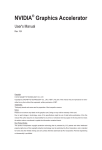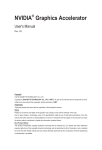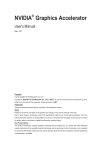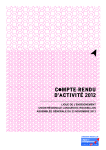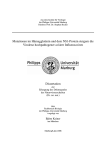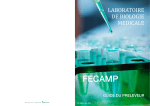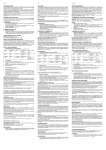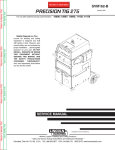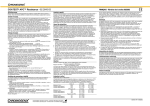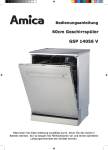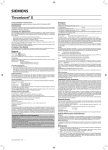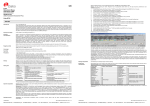Download Coamatic APC Resistance V S 82313863
Transcript
COATEST™ APC™ Resistance V S - 82 3138 63 Intended use For determination of resistance to activated protein C (APC), caused by the factor V:Q 506 (factor V Leiden) mutation, in plasma from untreated individuals and from patients on oral anticoagulant (OAC) or heparin therapy. Background and summary The APC resistance phenotype 1,2 is in more than 90% of the cases due to a mutation in the factor V gene, resulting in a replacement of Arg 506 (R) with Gln (Q) in the factor V protein 3-5. The selectivity for the factor V:Q 506, or other mutations in the factor V gene rendering the protein resistant to inactivation by APC 6 , is increased by normalizing the concentrations of other plasma proteins involved in formation and regulation of thrombin. Hence, by performing the APTT-based APC resistance assay in the presence of an excess of factor V deficient plasma, the sensitivity and specificity for the factor V:Q 506 mutation is significantly increased. Further, this modification allows for the analysis of plasma from patients who are on OAC therapy 7-11. Measurement principle Sample plasma is prediluted in V-DEF Plasma and incubated with the APTT reagent for a standard period of time. Coagulation is triggered by the addition of CaCl2 in the absence and presence of APC and the time for clot formation is recorded. REAGENTS 1. V-DEF Plasma 2 vials Stabilized, lyophilized human plasma, with a low level of factor V activity, containing the heparin antagonist Polybrene®. Reconstitute with 4.0 mL of NCCLS type II water 12. Allow to stand for 30 minutes at 20-25°C. Swirl gently before use. 2. CaCl2 2 vials 2 mL of calcium chloride, 0.025 mol/L, in Tris buffer containing 0.5% bovine serum albumin. 3. 3. APTT reagent 2 vials 4 mL of purified phospholipids with colloidal silica as contact activator. Contains a preservative. Mix thoroughly on a Vortex mixer before use. 4. 4. APC/CaCl2 2 vials Human activated protein C colyophilized with CaCl2. Reconstitute with 2.0 mL of NCCLS type II water 12. Allow to stand for 30 minutes at 20-25°C. Swirl gently before use. 5. 5. Control Plasma Level 1 1 vial Lyophilized human plasma. Reconstitute with 1.0 mL of NCCLS type II water 12. Allow to stand for 30 minutes at 20-25°C. Swirl gently before use. 6. 6. Control Plasma Level 2 1 vial Lyophilized human plasma. Reconstitute with 1.0 mL of NCCLS type II water 12. Allow to stand for 30 minutes at 20-25°C. Swirl gently before use. Reagents 3 and 4 are not interchangeable between lots. V-DEF Plasma (Art. No 82 3146 63), Control Plasma Level 1 (Art. No 82 2650 63) and Control Plasma Level 2 (Art. No 82 2668 63) are also available separately from Chromogenix. CAUTION: Each donor unit used in the preparation of human source reagent has been tested by FDA approved methods for the presence of Hepatitis B surface antigen and antibodies to HIV 1 and 2 and Hepatitis C and found to be negative. However, since no test can completely rule out the presence of these blood borne diseases, the handling and disposal of human source reagents from this product should be made with care. Hazard class: none Risk phrases: none Safety phrases: none This product is for in vitro diagnostic use. Materials required but not provided: — Deionized water, filtered through 0.22 µm or NCCLS type II water12 — Calibrated pipettes. — Automated or semi-automated coagulation instruments which, employ mechanical or optical detection, methods should be used. NOTE: When using automated or semi-automated instruments, always refer to the operator manual from the instrument manufacturer for exact procedures. Storage conditions and stability ENGLISH - Insert revision 03/2013 2. CaCl2 Opened reagent in the original vial is stable for 1 week at 15-25°C or 1 month at 2-8°C. 3. APTT reagent Opened reagent in the original vial is stable for 1 week at 15-25°C or 1 month at 2-8°C. Do not freeze! 4. APC/CaCl2 Stability after reconstitution is 2 hours at 37°C, 8 hours at 15-25°C, 5 days at 2-8°C or 3 months at -20°C or below when stored in the original vial. *See NOTE. 5. Control Plasma Level 1 Stability after reconstitution is 6 hours at 2-25°C or 3 months at -20°C or below whenstored in the original vial. *See NOTE. 6. Control Plasma Level 2 Stability after reconstitution is 6 hours at 2-25°C or 3 months at -20°C or below when stored in the original vial. *See NOTE. *NOTE: Frozen reagent should be rapidly thawed at 37°C and gently mixed before use. Do not refreeze. Quality controls Control Plasma Level 1 and Level 2 should be used for validation of the assay series. Level 1 shows a normal response to APC whereas Level 2 shows a response consistent with presence of the factor V:Q 506 mutation. Ranges of expected APC-V ratios are provided with each batch. If values outside the specified range are obtained, a complete check of reagents and instrument performance should be made and the analysis should be repeated. (See Calibration section for QC use of Control Plasma Level 1 and 2). Traceability of calibrators and control materials The reported values were determined over multiple runs on ACL Futura using a specific lot of reagent and against an internal House Standard. As an International Standard is not still availablefor the APCR-V assay, the values have been assigned against a House Standard which is traceable to frozen plasma samples which have been determined to be homozygous or heterozygous respectively for factor V dependent APC Resistance. Specimen collection The patient should be at rest for 10 min. before sampling. Collect blood (9 volumes) in 0.1 mol/L sodium citrate (1 volume) and centrifuge within 24 hours at 2000 x g for 20 min. at room temperature. Take care to avoid contamination from the platelet layer into the plasma when the plasma is separated from the cells. Analyse the plasma within 25 hours from blood sampling 13. Alternatively, freeze rapidly at -70°C in aliquots of 1 mL or less and store for not more than 3 years at -70°C. Specimens should not be stored in a self defrosting freezer and not be thawed and refrozen before assay. Treat specimens as potentially infectious. For more infor-mation see NCCLS document H21-A3 14. Procedure 1. A ll reagents must be brought to room temperature before use. Frozen plasma samples should be rapidly thawed at 37°C in a standardized way ensuring negligible loss of activity of labile coagulation factors and absence of cryoprecipitate. 2. Pre-warm a sufficient volume of CaCl2 and APC/CaCl2 at 37±0.5°C. 3. Pre-dilute one volume of sample plasma or Control Plasma with four volumes of V-DEF Plasma. Pre-diluted plasma should be analyzed within 45 minutes. 4. Add one volume of plasma to a test tube or cuvette, then add an equal volume of the APTT reagent. Incubate at 37°C for 5 minutes. An instrument with a different, preset, incubation time may be used provided it is at least 3 minutes. 5. Add one volume of CaCl2 and simultaneously begin timing of clot formation. Record the time for clot formation. 6. Perform a second analysis on the plasma exchanging CaCl2 with APC/CaCl2 and record the time for clot formation. Results Calculate the factor V related APC ratio for the samples and controls: Clot time APC/CaCl2 APC ratio = Clot time CaCl2 APC resistance due to a factor V mutation is indicated when the APC-V ratio is below or equal to the cut-off value (see Calibration). The following results illustrate the applicability of the Coatest APC Resistance V assay on the analysis of plasma from untreated individuals (Untreated), patients on OAC therapy, INR 1.3 - 6.0 (OAC), and patients receiving unfractionated heparin (Heparin) or low molecular weight heparins (shown here are Fragmin® and Fraxiparin®). The sealed reagents are stable at 2-8°C until the expiry date printed on the label. Avoid contamination of the reagents by microorganisms. 1. V-DEF Plasma Stability after reconstitution is 8 hours at 15-25°C, 24 hours at 2-8°C or 3 months at -20°C or below when stored in the original vial. *See NOTE. APC-V ratio 3.5 3.0 normal genotype 2.5 2.0 heterozygous FV:Q506 1.5 homozygous FV:Q506 1.0 Untreated n=61 OAC n=147 Heparin n=36 Fragmin n=9 Fraxiparin n=12 Sample APC-V ratios are distributed according to the factor V genotype. For a given genotype, similar APC-V ratios are obtained regardless of patient group. Typical median values are 2.6 (normal), 1.7 (heterozygous FV:Q 506 ) and 1.2 (homozygous FV:Q 506 ). Basal APT times for untreated individuals may differ moderately as compared to the original Coatest APC Resistance assay. Performance Characteristics PRECISION APC-V ratios were calculated from 22 single replicate analyses of Control Plasma Level 1 on an ACL instrument using 11 different reagent combinations on 11 different occasions. CV% (Within series) CV% (Between series) Control Plasma Level 1 APC-V ratio 2.4 4 % 4 % Duplicate analyses of plasma from altogether 630 individuals on three different types of instruments (ST-4, Thrombolyzer and MLA/Electra 900) resulted in within series CV 3% and 5% for the clotting times obtained in the absence and presence of APC respectively. NCCLS document EP5-T215. Calibration APC-V ratios obtained with the Coatest APC Resistance 5 method are lower than the APC ratios obtained with the original Coatest APC Resistance method, independent of instrumentation used. It is recommended that each user establishes the performance of his own instrument and determines the factor V related APC resistance cut-off value through the following procedure: 1. Perform five independent determinations of the APC-V ratio, using at least triplicates in each series, of a plasma sample with normal APC response. Confirm that the inter and intra assay variation of the APC-V ratio is below 7%. In case a satisfactory performance already has been established with the original Coatest APC Resistance method, this step may be omitted. 2. Determine the APC-V ratios for at least 30 plasma samples from healthy individuals in the age range 20 - 65 years. Include Control Plasma Level 1 and Level 2 for assay validation. 3. Verify that the APC-V ratios for the Control Plasmas are within their specified ranges. 4. Calculate the median APC-V ratio. 5. Calculate the factor V related APC resistance cut-off value as 0.8 times the median APC-V ratio when below 2.8 and as 0.75 times the median APC-V ratio when 2.8 or higher. 6. The APC-V ratio for Control Plasma Level 1 should be within the normal range. The APC-V ratio for Control Plasma Level 2 should be below the cut-off value. Sensitivity Coatest APC Resistance V provides 100% sensitivity for FV:Q 506 as determined on Thrombolyzer (n = 447), ACL (n = 295), ST-4 (n = 248) and MLA/Electra (n = 50). Limitation/interfering factors No significant differences are obtained between fresh and frozen samples. The sensitivity and specificity for the factor V:Q 506 mutation on analysis of plasma from OAC patients is not affected by the INR value. The prescribed assay procedure allows for the analysis of plasma from heparinized patients at heparin levels < 1 IU/mL plasma (unfractionated and low molecular weight heparins). Although the 1+4 predilution strongly decreases interferences, it can not be excluded that analysis of plasma from patients with high inhibitor activity (e.g. phospholipid antibodies) may give an abnormal APT time and thus possibly misleading results. In such cases, increasing the dilution factor (e.g. 1+9 or 1+19) may correct the test result. As for any APTT-based assay, care should be taken to avoid contact activation of samples since this may lead to activation of FVIII and FV. Reference values The APC-V ratios obtained from analysis of plasmas from 61 healthy individuals on ACL and ST-4 and from 390 healthy individuals on Thrombolyzer were in the range 2 - 3.5. No difference is found between sexes. COATEST™ APC™ Resistance V S - 82 3138 63 Verwendungszweck Zur Bestimmung der, durch die Faktor V:Q506 (Faktor V Leiden) Punktmutation verursachten, Resistenz gegen aktiviertes Protein C (APC) bei nicht therapierten Personen und Patienten unter oraler Antikoagulation (OAK) bzw. Heparintherapie. Hintergrund und Zusammenfassung Mehr als 90% aller Fälle von APC-Resistenz1, 2 sind durch eine Mutation im Faktor V Gen erklärbar. Diese Mutation führt, genau an einer Spaltstelle durch aktiviertes Protein C, zu einer Aminosäuresubstitution (Arg506∅Gln) im Faktor V Protein3-5. Durch diese Änderung in der Aminosäuresequenz wird die Spaltung und Inaktivierung des Faktor Va durch APC gehemmt. Die Selektivität für diese oder andere Mutationen des Faktor V6 wird durch Normalisierung der Konzentration anderer, bei der Bildung und Regulierung von Thrombin beteiligten, Plasmaproteinen erhöht. Durch die Vorverdünnung der Patientenplasmen mit V-DEF Plasma wird die Sensitivität und Spezifität des, auf dem Grundprinzip der APTT-Messung aufbauenden, APC Resistenz Tests für die Faktor V:Q506 Mutation signifikant erhöht. Außerdem ermöglicht die Vorverdünnung auch die Testung von Patienten unter oraler Antikoagulanzientherapie7-11. Messprinzip Probenplasma wird mit V-DEF Plasma vorverdünnt und für einen festgesetzten Zeitraum mit dem APTT Reagenz inkubiert. Die Zeitdauer bis zur Fibrinbildung wird nach Zugabe von CaCl2 mit und ohne APC gemessen. REAGENZIEN 1. V-DEF Plasma 2 Flaschen Stabilisiertes, lyophilisiertes humanes Plasma mit einer niedrigen Faktor-V Restaktivität und Polybrene® als Heparinantagonist. Auflösen mit 4,0 mL Wasser NCCLS Typ II.12 30 Minuten bei Raumtemperatur stehen lassen. Vor Verwendung vorsichtig durchmischen. 2. CaCl2 2 Flaschen 2 mL Calciumchlorid, 0,025 mol/L in Trispuffer mit 0,5% Rinderserumalbumin. 3. APTT Reagenz 2 Flaschen 4 mL gereinigte Phospholipide mit kolloidalem Silika als Kontaktaktivator. Enthält ein Konservierungsmittel. Vor Verwendung vorsichtig auf einem Vortex Mixer durchmischen. 4. APC/CaCl2 2 Flaschen Humanes aktiviertes Protein C, lyophilisiert in Kombination mit CaCl2. Auflösen mit 2,0 mL Wasser NCCLS Typ II.12 30 Minuten bei Raumtemperatur stehen lassen und vor Verwendung vorsichtig durchmischen. 5. Kontrollplasma Level 1 1 Flasche Lyophilisiertes humanes Plasma. Auflösen mit 1,0 mL Wasser NCCLS Typ II.12 30 Minuten bei Raumtemperatur stehen lassen und vor Verwendung vorsichtig mischen. 6. Kontrollplasma Level 2 1 Flasche Lyophilisiertes humanes Plasma. Auflösen mit 1,0 mL Wasser NCCLS Typ II.12 30 Minuten bei Raumtemperatur stehen lassen und vor Verwendung vorsichtig mischen. Die Reagenzien 3 und 4 sind bei verschiedenen Kit-Chargen nicht untereinander austauschbar. V-DEF Plasma (Art.Nr. 82 3146 63), Kontrollplasma Level 1 (Art.Nr. 82 2650 63) und Kontrollplasma Level 2 (Art.Nr. 82 2668 63) sind auch separat von Chromogenix erhältlich. ACHTUNG: Jede individuelle Blutspende, die zur Herstellung der Reagenzien verwendet wurde, ist mit FDA zugelassenen Methoden auf die Abwesenheit von Hepatitis B Oberflächenantigen und auf Antikörper gegen HIV 1 bzw. 2 und Hepatitis C überprüft. Unabhängig davon sollten alle, aus menschlichen Blut gewonnenen, Proben und Produkte, wegen nie völlig auszuschließender Gefährdung durch Krankheitserreger, als potentiell infektiös angesehen und mit angemessener Sorgfalt gehandhabt werden. Gefahrenklasse: keine Risikoeinstufung: keine Sicherheitseinstufung: keine Dieses Produkt ist nur für die in vitro Diagnostik geeignet. Zusätzlich benötigte Materialien — Entionisiertes Wasser 0,22 µm filtriert oder Wasser NCCLS Typ II.12 — Kalibrierte Pipetten. — Gerinnungsmeßgerät zur Bestimmung der Gerinnungszeit. Automatische bzw. halbautomatische Gerinnungsmeßgeräte mit mechanischer oder optischer Messmethodik können verwendet werden. ANMERKUNG: Bei Verwendung von automatischen oder halbautomatischen Geräten sind die Angaben des Geräteherstellers zu befolgen. Haltbarkeit und Lagerungsbedingungen Die verschlossenen Reagenzien sind bei 2-8°C bis zum aufgedruckten Verfalldatum haltbar. Eine Kontamination mit Mikroorganismen ist zu vermeiden. 1. V-DEF Plasma Haltbarkeit nach dem Lösen: 8 Stunden bei 15-25°C, 24 Stunden bei 2-8°C oder 3 Monate bei -20°C oder kälter in der Orginalflasche. *Siehe ANMERKUNG. DEUTSCH - Beipackzettel Version 03/2013 2. CaCl2 Haltbarkeit der geöffneten Flasche: 1 Woche bei 15-25°C oder 1 Monat bei 2-8°C in der Orginalflasche. 3. APTT Reagenz Haltbarkeit der geöffneten Flasche: 1 Woche bei 15-25°C oder 1 Monat bei 2-8°C in der Orginalflasche. Nicht einfrieren! 4. APC/CaCl2 Haltbarkeit nach dem Lösen: 2 Stunden bei 37°C, 8 Stunden bei 15-25°C, 5 Tage bei 2-8°C oder 3 Monate bei -20°C oder kälter in der Orginalflasche. *Siehe ANMERKUNG. 5. Kontrollplasma Level 1 Haltbarkeit nach dem Lösen: 6 Stunden bei 2-25°C oder 3 Monate bei -20°C oder kälter in der Orginalflasche. *Siehe ANMERKUNG. 6. Kontrollplasma Level 2 Haltbarkeit nach dem Lösen: 2 Stunden bei 2-25°C oder 3 Monate bei -20°C oder kälter in der Orginalflasche. *Siehe ANMERKUNG. *ANMERKUNG: Das gefrorene Reagenz muß bei 37°C aufgetaut und vor Verwendung vorsichtig durchmischt werden. Nicht wieder einfrieren! Qualitätskontrolle Die Kontrollplasmen Level 1 und Level 2 sollten zur Bestätigung der Patientenergebnisse mitgetestet werden. Level 1 ist ein Plasma mit normaler Reaktion, wogegen Level 2 eine, dem Vorhandensein der Faktor V:Q506 Mutation entsprechende, Reaktion zeigt. Die zu erwartenden APC-V Ratio Kontrollbereiche sind im chargenspezifischen Beipacktext angegeben. Liegen die erhaltenen Werte außerhalb der angegebenen Kontrollbereiche, sollten Reagenzien bzw. Gerät überprüft und der Test wiederholt werden. Rückführbarkeit der Werte von Kalibratoren und Kontrollen Die angegebenen Werte wurden in mehreren Analysenserien auf ACL Futura unter Verwendung einer bestimmten Reagenzcharge und eines internen Laborstandards ermittelt. Da für die Bestimmung der APC-Resistenz noch kein Internationaler Standard verfügbar ist, sind die Werte des internen Laborstandard auf gefrorene Plasmaproben zurückführbar, die als homozygot bzw. heterozygot für APC-Resistenz nachgewiesen wurden. Probengewinnung Die Blutabnahme vornehmen, nachdem sich der Patient 10 Minuten ausgeruht hat. Das Blut (9 Teile) in Natriumcitrat (0,1 mol/L - 1 Teil) geben und innerhalb von 24 Stunden bei 2000 x g und Raumtemperatur zentrifugieren. Das Plasma vorsichtig - ohne Durchmischung mit Thrombozyten - von den Zellen trennen. Die Plasma-Untersuchung muß innerhalb von 25 Stunden nach der Blutabnahme erfolgen.13 Es besteht aber auch die Möglichkeit, die Blutproben rasch bei -70°C in 1 mL-Einheiten oder kleiner tiefzufrieren und sie bei -70°C höchstens drei Jahre lang aufzubewahren. Die Proben dürfen nicht in einer Gefriertruhe mit einem automatischen Abtausystem gelagert, noch vor dem Test aufgetaut und wieder eingefroren werden. Die Proben sind als potentiell infektiös zu behandeln. Zusätzliche Informationen sind im NCCLS-Dokument H21-A3 zu finden.14 Testdurchführung 1. Alle Reagenzien vor Verwendung auf Raumtemperatur bringen. Gefrorene Proben werden unter standardisierten Bedingungen rasch bei 37°C aufgetaut, um Aktivitätsverluste von labilen Gerinnungsfaktoren bzw. die Bildung von Kryopräzipitaten zu vermeiden. 2. Die benötigten Volumina CaCl2 und APC/CaCl2 auf 37±0,5°C vorwärmen. 3. 1 Teil Probe oder Kontrollplasma mit 4 Teilen V-DEF Plasma verdünnen (z.B. 25 µL + 100 µL). Die Vorverdünnung im Plasma ist innerhalb 45 Minuten zu analysieren. 4. Einen Teil verdünntes Plasma in ein Teströhrchen oder eine Küvette pipettieren und das gleiche Volumen APTT Reagenz hinzufügen. 5 Minuten bei 37°C inkubieren. Geräte mit davon abweichenden, vorprogrammierten Inkubationszeiten, können verwendet werden- vorausgesetzt, die Inkubationsdauer beträgt mindestens 3 Minuten. 5. Einen Teil CaCl2 hinzufügen und gleichzeitig mit der Zeitmessung bis zur Fibrinbildung beginnen. 6. Einen zweiten Ansatz mit APC/CaCl2 anstelle von CaCl2 durchführen und abermals die Zeit bis zur Fibrinbildung stoppen. Resultate Berechnung der Faktor-V bezogenen APC Ratios für Proben und Kontrollen: Gerinnungszeit APC/CaCl2 APC Ratio = Gerinnungszeit CaCl2 Eine APC-V Ratio kleiner oder gleich dem cut-off Wert (siehe KALIBRATION) zeigt eine, durch die FV:Q506 Mutation verursachte, APC Resistenz an. Die angeführten Resultate zeigen die Eignung des COATEST APC Resistance 5 Tests bei der Analyse von nicht therapierten Personen, Patienten unter OAK-Therapie (OAK, INR 1,3 - 6,0) und Patienten mit unfraktionierter Heparingabe (Heparin) oder niedermolekularer Heparingabe (Fragmin®, Fraxiparin®). APC-V ratio 3.5 3.0 normal genotype 2.5 2.0 heterozygous FV:Q506 1.5 homozygous FV:Q506 1.0 Untreated n=61 OAC n=147 Heparin n=36 Fragmin n=9 Fraxiparin n=12 Die Verteilung der APC-V Ratios entspricht dem Faktor-V Genotyp. Innerhalb eines Faktor-V Genotyps werden, unabhängig von der Probenkategorie, ähnliche APC-V Ratios erhalten. Typische, durchschnittliche, Werte sind 2,6 (normaler Genotyp), 1,7 (heterozygoter FV:Q506) und 1,2 (homozygoter FV:Q506). Die Ausgangs - APTT bei nicht therapierten Personen, kann sich im Vergleich zur COATEST APC-Resistenz Originalmethode leicht verändern. Testeigenschaften REPRODUZIERBARKEIT UND PRÄZISION 22 APC-V Ratios von Kontrollplasma Level 1 wurden mit 11 verschiedenen Reagenzkombinationen an verschiedenen Tagen auf einem ACL Gerinnungsautomaten getestet: APC-V Ratio Innerhalb der Serien Zwischen den Serien Kontrollplasma Level 1 2,0 CV 4% CV 4% Doppelbestimmungen der Plasmen von 630 Personen auf drei verschiedenen Instrumenten (ST-4, Thrombolyzer und MLA/Electra 900) ergaben einen CV innerhalb der Serie von 3% bzw. 5% für die Gerinnungszeiten ohne bzw. mit APC. NCCLS Referenz EP5-T2.15 Kalibrierung Im Vergleich zur COATEST APC Resistance Originalmethode werden mit der V-DEF Plasma Methode niedrigere Ratios erhalten. Es wird empfohlen, daß jedes Labor für das verwendete Gerät einen eigenen APC Resistenz cut-off Wert festlegt: 1. Durchführung von fünf voneinander unabhängigen Dreifachbestimmungen einer Probe mit normaler APC-Response. Die inter und intra Variation der APC-R Ratios muß unter 7% liegen. Für den Fall, daß mit der Originalmethode bereits eine zufriedenstellende Testdurchführung festgestellt wurde, kann dieser Schritt entfallen. 2. Bestimmung der APC-V Ratios von mindestens 30 gesunden Personen im Alter von 20-65 Jahren und der Kontrollplasmen Level 1 und 2. 3. Die APC-V Ratios der Kontrollplasmen müssen innerhalb des angegebenen Kontrollbereiches liegen. 4. Die mittlere APC-V Ratio berechnen. 5. Der cut-off Wert bei einer durchschnittlichen Ratio von unter 2,8 beträgt 80% der ermittelten Durchschnittsratio. Ist die durchschnittliche APC-V Ratio ž 2,8, so beträgt der cut-off Wert 75% der Durchschnittsratio. 6. Die APC-V Ratio des Kontrollplasmas Level 1 muß innerhalb des Normalbereiches liegen, die Ratio des Kontrollplasmas Level 2 muß unterhalb des cut-off Wertes liegen. Sensitivität Die Sensitivität für die FV:Q506 Mutation ist 100%, erstellt auf Thrombolyzer (n = 447), ACL (n = 295), ST-4 (n = 248) und MLA/Electra (n = 50). Grenzen des Verfahrens/interferenzen Die APC-V Ratios von frischen und gefrorenen Proben zeigen keine signifikanten Unterschiede. Der INR von Patienten unter oraler Antikoagulanzientherapie beeinflußt nicht die Sensitivität und Spezifilität für die Faktor V:Q506 Mutation. Diese APC-V Methode ermöglicht die Testung von heparinisierten Patienten mit einem Heparingehalt von 1,0 IE/mL Plasma (unfraktioniertes und niedermolekulares Heparin). Obwohl die 1+4 Vorverdünnung eventuelle Interferenzen stark reduziert, kann bei Patienten mit einer sehr hohen Inhibitoraktivität (z.B. Phospholipid Antikörper) eine Beeinflussung der APTT und somit des Testresultates nicht ausgeschlossen werden. In solchen Fällen kann eine höhere Probenvorverdünnung (1+9 oder 1+19) eine korrekte Analyse ermöglichen. Wie bei allen APTT basierenden Tests, muß eine Kontaktaktivierung der Proben vermieden werden, da dies zur Aktivierung von FVIII und FV führen kann. Referenzwerte Die APC-V Ratios von 61 gesunden Personen, gemessen auf ACL und ST-4 bzw. 390 gesunden Personen, gemessen auf Thrombolyzer, lagen im Bereich von 2,0-3,5. COATEST™ APC™ Resistance V S - 82 3138 63 COATEST™ APC™ Resistance V S - 82 3138 63 COATEST™ APC™ Resistance V S - 82 3138 63 PORTUGUÊS - Revisão do folheto 03/2013 DANSK - Metodeforskrift revision 03/2013 Para a revisao actual deste folheto informativo em Portugues, contacte o representante da Chromogenix da sua área. PRECAUÇÕES E ADVERTÊNCIAS: O material utilizado neste produto foi analisado com testes aprovados pela FDA e verificou-se a ausência de reacção ao Antigénio de Superfície da Hepatite B (HBsAg), aos anticorpos anti-HCV e anti-HIV 1/2. No entanto, deve-se manipular com precaução, como potencialmente infeccioso. Classe de risco: nenhuma Frases de risco: nenhuma Frases de segurança: nenhuma Este reagente destina-se a utilização em diagnóstico in vitro. TRAÇABILIDADE DAS MATÉRIAS DOS CALIBRADORES E DOS CONTROLOS. Os valores apresentados foram determinados através de múltiplos ensaios no ACL Futura, utilizando um lote especifico de reagente e contra um Padrao Caseiro interno. Para o ensaio de APCR-V o Padrao Internacional ainda nao está disponível. Os valores foram determinados contra um Padrao Caseiro que é traçável até rs amostras de plasma ongelado que foram determinadas como sendo Homozigotas e Heterozigotas para a APCR. Venligst rekvirer den gældende udgave af metodeforskriften på dansk fra den lokale Chromogenix distributør. ADVARSEL: Alle donor portioner anvendt til fremstilling af reagenser af human oprindelse er testet med FDA godkendte metoder for tilstedeværelse af Hepatitis B overflade antigen og antistoffer mod HIV 1 og 2 samt Hepatitis C og fundet negative. Da ingen analyse imidlertid kan udelukke tilstedeværelsen af disse blodbårne sygdomme, bør håndtering af og affald fra reagenser af human oprindelse i dette produkt ske med omhu. Fareklasse: Ingen Risikosærninger: Ingen Sikkerhedssætninger: Ingen Dette produkt er til in vitro diagnostisk anvendelse. SPORBARHED AF KALIBRATORER OG KONTROLLER De angivne værdier blev bestemt ved gentagne analyser på ACL Futura med en specifik reagens-lot og mod en intern standard. For APCR-V analysen er der endnu ikke fastlagt en International Standard. Værdierne er sat mod en intern standard, som er sporbar til frosne plasma prøver, som er blevet bestemt til at være henholdsvis homozygote og heterozygote for APCR. 03/2013 COATEST™ APC™ Resistance V S - 82 3138 63 Σήμα κινδύνου Κατηγορία: ουδέν Φράσεις κινδύνου: ουδέν Φράσεις οδηγιών ασφαλούς χρήσης: ουδέν SVENSK - Instick revision 03/2013 För aktuell revision av detta insticksblad på svenska ber vi Er att kontakta Chromogenix distributör. FÖRSIKTIGHETSÅTGÄRDER OCH VARNINGAR: Materialet i denna produkt har testats med FDA godkända metoder och befunnits negativt för Hepatit B ytantigen (HBsAg), Anti-HCV och HIV antikroppar. Produkten skall hanteras som potentiellt smittsam. Faroklass: ingen Riskfraser: ingen Skyddsfraser: ingen Denna produkt är för in vitro diagnostiskt användande SPÅRBARHET AV KALIBRATORER OCH KONTROLLMATERIAL: Angivna värden bestäms genom upprepade analyser på ACL Futura med användande av en specifik reagenslot. Kalibrering görs mot en intern husstandard. Eftersom det ännu inte finns någon internationell standard för APCR-V testet har värden åsatts mot en intern husstandard som är spårbar till frusna plasmaprover vilka har befunnits vara heterozygota resp. homozygota för faktor V-beroende APC resistens. Bibliography / Literatur / Bibliografía / Bibliographie / Bibliografia /Bibliografia / Litteratur / Litteraturförteckning / 1. Dahlbäck B et al. Familial thrombophilia due to a previously unrecognized mechanism characterized by poor anticoagulant response to activated protein C: Prediction of a cofactor to activated protein C. Proc Natl Acad Sci 90, 1004-1008. (1993) 2. Svensson P J and Dahlbäck B. Resistance to activated protein C as a basis for venous thrombosis. N Engl J Med 330, 517-522 (1994). 3. Bertina R M et al. Mutation in blood coagulation factor V associated with resistance to activated protein C. Nature 369, 64-67 (1994). 4. Voorberg J et al. Association of idiopathic venous thromboembolism with single point mutation at Arg506 of factor V. Lancet 343, 1535-1536 (1994). 5. Greengard J S et al. Activated protein C resistance caused by Arg506Gln mutation in factor Va. Lancet 343, 13611362 (1994). 6. Williamson D et al. Factor V Cambridge: A new mutation (Arg306->Thr) associated with resistance to activated protein C. Blood 91, 1140-1144 (1998). 7. Jorquera J I et al. Modified test for activated protein C resistance. Lancet 344, 1162-1163 (1994). 8. Trossaërt M et al. Modified APC resistance assay for patients on oral anticoagulants. Lancet 344, 1709 (1994). 9. Svensson PJ et al. Evaluation of original and modified APC-resistance tests in unselected outpatients with clinically suspected thrombosis and in healthy controls. Thromb Haemost 77, 332-335 (1997). 10. Freyburger G et al. Proposal for objective evaluation of the performance of various functional APC-resistance tests in genotyped patients. Thromb Haemost 78, 1360-1365 (1997). 11. Hall C et al. Evaluation of a modified APTT-based method for determination of APC resistance in plasma from patients on heparin or oral anticoagulant therapy. Thromb Res 89, 203-209 (1998). 12. National Committee for Clinical Laboratory Standards. Specifications for reagent water used in the clinical laboratory, NCCLS Approved Standard: ASC-3. 13. Freyburger G et al. Response to activated protein C upon storage of whole blood and plasma. Thromb Res 93, 89-95 (1999). 14. National Committee for Clinical Laboratory Standards. Collection, transport and processing of blood specimens for coagulation testing and performance of coagulation assays,NCCLS Document H21-A3; vol. 11 No. 23. 15. National Committee for Clinical Laboratory Standards. EP5-T2. User evaluation of clinical chemistry devises. US Patent 5,443,960; EP 0 608 235; EP 0 690 991; Australia 666 484; 690 535; Japan 2562000; Canada 2,119,761; New Zealand 261 190. Symbols used / Verwendete Symbole / Símbolos utilizados / Symboles utilisés / Simboli impiegati / Símbolos utilizados / In Vitro Diagnostic Medical Device In Vitro Diagnostikum Dispositif medical de diagnostique in vitro Producto sanitario para diagnóstico in vitro Dispositivo medicodiagnostico in vitro Dispositivo médico para utilização em diagnóstico in vitro Medicinsk udstyr til in vitro-diagnostik In vitro diagnostisk medicinsk produkt Batch code Chargenbezeichnung Codigo de lote Code du lot Codice del lotto Número de lote Batchkoden Tillverkningskod Use by Verwendbar bis Fecha de caducidad Utiliser jusque Utilizzare entro Data límite de utilização Anvendelsesdato Användning Temperature limitation Zulässiger Temperaturebereich Limite de temperatura Limites de température Limite di temperatura Límite de temperatura Temperaturbegrænsning Temperatur gräns Instrumentation Laboratory Company - Bedford, MA 01730-2443 (USA) Instrumentation Laboratory SpA - V.le Monza 338 - 20128 Milano (Italy) Consult instructions for use Gebrauchsanweisung beachten Consulte las instrucciones de uso Consulter les instructions d’utilisation Consultare le istruzioni per l’uso Consultar as instruções de utilização Se instruktion før brug Ta del av instruktionen före användning Control Kontrollen Control Contrôle Controllo Controlo Kontrol Kontroll Biological risks Biologisches Risiko Riesgo biológico Risque biologique Rischio biologico Risco biológico Miljø oplysninger Biologiska risker Manufacturer Hersteller Fabricante Fabricant Fabbricante Fabricado por Producent Tillverkare Authorised representative Bevollmächtigter Representante autorizado Mandataire Rappresentanza autorizzata Representante autorizado Leverandør Auktoriserad representant 302251 R3 03/2013 COATEST™ APC™ Resistance V S - 82 3138 63 Uso Para la determinación de la resistencia a la proteína C activada (APC), causada por la mutación en el factor V:Q506 (factor V Leiden), tanto en plasma de individuos sin tratamiento como en pacientes sometidos a terapias de anticoagulantes orales (TAO) o heparinas. Antecedentes y resumen El fenotipo1-2 del ”APC Resistance” es, en más del 90% de los casos, debido a una mutación en el gen del factor V que produce la sustitución de Arg506 (R) por Gln (Q) en la proteína del factor V.3-5 La selectividad en el factor V:Q506 u otras mutaciones en el gen del factor V que produzcan la resistencia de la proteína a la inactivación por APC6, es aumentada al normalizar la concentración de las otras proteinas plasmáticas implicadas en la formación y regulación de la trombina. Por tanto, al llevar a cabo el APTT en el que se basa el ensayo de APC Resistance, en presencia de un exceso de plasma deficiente en factor V, la sensibilidad y especificidad para la mutación del factor V:Q506 aumenta significativamente. Además, esta modificación permite el análisis de plasma de pacientes que están con terapias de (TAO).7-11 ESPAÑOL - Revisión Folleto 03/2013 2. CaCl2 Estabilidad una vez abierto: 7 días a 15-25°C o 1 mes a 2-8°C en el vial original. 3. APTT reactivo Estabilidad después de reconstituido: 7 días a 15-25°C o 1 mes a 2-8°C en el vial original. No congelar. 4. APC/CaCl2 Estabilidad después de reconstituido: 2 horas a 37°C, 8 horas a 15-25°C, 5 días a 2-8°C o 3 meses a -20°C o temperatura inferior en el vial original. *Ver NOTA. 5. Control Plasma Nivel 1 Estabilidad después de reconstituido: 6 horas a 2-25°C o 3 meses a -20°C o temperatura inferior en el vial original. *Ver NOTA. 6. Control Plasma Nivel 2 Estabilidad después de reconstituido: 6 horas a 2-25°C o 3 meses a -20°C o temperatura inferior en el vial original. *Ver NOTA. *NOTA: El reactivo congelado debería ser atemperado a 37°C. Agitar suavemente antes de usar. No volver a congelar. Fundamento del metódo Controles de calidad La muestra de plasma es prediluida en Plasma DEF-V e incubada con el reactivo APTT durante un periodo de tiempo estándar. La coagulación se inicia al añadir CaCl2 en ausencia y presencia de APC y se registra el tiempo de formación del coágulo. REACTIVOS 1. V-DEF Plasma 2 viales Plasma humano estabilizado y liofilizado, con un bajo nivel de actividad en factor V, conteniendo el antagonista de la heparina Polibrene®. Reconstituir con 4 mL de agua NCCLS tipo II.12 Se puede mantener 30 min a 20-25°C. Agitar suavemente antes de usar. 2. CaCl2 2 viales 2 mL de cloruro cálcico, 0.025 mol/L, en tampón Tris conteniendo 0.5% de albúmina bovina. 3. APTT reactivo 2 viales 4 mL de fosfolípidos purificados con sílica coloidal como activador de contacto. Contiene un conservante. Agitar vigorosamente en un vórtex antes de usar. 4. APC/CaCl2 2 viales Proteína C activada humana coliofilizada con CaCl2. Reconstituir con 2 mL de agua NCCLS tipo II.12 Se puede mantener durante 30 minutos a 20-25°C; mezclar suavemente antes de usar. 5. Control Plasma Nivel 1 1 vial Plasma humano liofilizado. Reconstituir con 1.0 mL de agua NCCLS tipo II.12 Se puede mantener durante 30 minutos a 20-25°C; agitar suavemente antes de usar. 6. Control Plasma Nivel 2 1 vial Plasma humano liofilizado. Reconstituir con 1.0 mL de agua NCCLS tipo II.12 Se puede mantener durante 30 minutos a 20-25°C; agitar suavemente antes de usar. * Los reactivos 3 y 4 no son intercambiables entre lotes. Chromogenix suministra también separadamente: V DEF Plasma (Art 82 3146 63), Plasma Control Nivel 1 (Art 82 2650 63) y Plasma Control Nivel 2 (Art 82 2668 63). PRECAUCIÓN: Cada muestra de donante empleada en la preparación de reactivos de procedencia humana ha sido ensayada con los métodos vigentes de la FDA (Food and Drug Administration) para determiner la presencia de antígenos de superficie de la hepatitis B y anticuerpos frente a VIH 1 y 2 y hepatitis C, siendo todos los resultados negativos. Sin embargo, puesto que no existe ningún análisis que descarte completamente la presencia de tales enfermedades sanguíneas, la manipulación y desechos de los reactivos de procedencia humana de este producto, ha de realizarse con cuidado. Indicaciones de peligro: Ninguna Frase de Riesgo: Ninguna Frase de Seguridad: Ninguna Este producto es para diagnóstico in vitro. Material requerido pero no proporcionado: — Agua desionizada, filtrada a través de un filtro de 0,22 µm o agua NCCLS tipo II.12 — Pipetas calibradas. — Instrumentos de coagulación automáticos o semi-automáticos que empleen métodos de detección óptico o mecánico. NOTA: Cuando usamos instrumentos automáticos o semi-automáticos, consultar el manual de intrucciones del fabricante del instrumento para seguir el proceso correcto. Deben usare los Plasmas Control Nivel 1 y Nivel 2 para la validación de las series de pruebas. El Nivel 1 muestra una respuesta normal a APC mientras que el Nivel 2 muestra una respuesta consecuente a la presencia de la mutación V:Q506. Los rangos de valores esperados para las razones de APC-V están especificados para cada lote. Si se obtienen valores fuera de este rango debe realizarse una revisión completa de los reactivos y de la funcionabilidad del instrumento y deben repetirse los análisis. Condiciones de almacenamiento y estabilidad Los reactivos sin abrir son estables a 2-8°C hasta la fecha de caducidad indicada en la etiqueta. Evitar la contaminación de los reactivos por microorganismos. 1. V-DEF Plasma Estabilidad después de la reconstitución: 8 horas a 15-25°C, 24 horas a 2-8°C o 3 meses a -20°C o temperatura inferior en el vial original. *Ver NOTA. Correlación de los calibradores y materiales de control. Los valores obtenidos se determinaron mediante múltiples mediciones en ACL Futura usando un lote específico de reactivo y con un estándar interno. En el aso del ensayo de APCR-V, el estándar internacional aún no está disponible. Lo valores se han asignado frente al estándar interno, el cual es correlacionable con muestras de plasma congelado que se han determinado como homocigóticas y heterocigóticas para APCR. Toma de muestras El paciente debe haber estado en reposo durante al menos diez minutos antes de tomar la muestra. Recoger la sangre (9 volúmenes) en 0,1 mol/L de citrato de sodio (1 volumen) y centrifugar dentro de las 24 horas siguientes a 2.000 x g durante 20 minutos a temperatura ambiente. Evitar la contaminación del plasma con células que forman parte de la capa de separación. Analizar el plasma dentro de las 25 horas siguientes a la toma de muestras.13 Como alternativa, puede congelarse rápidamente a -70°C en alícuotas de 1 mL o menos, y almacenar durante menos de tres años a -70°C. Las muestras no deben almacenarse en un congelador de descongelación automática, y no deben ser descongeladas y congeladas nuevamente antes de la prueba. Las muestras deben tratarse como potencialmente infecciosas. Para más informacion ver el documento H21-A3 NCCLS.14 Procedimiento 1. T odos los reactivos deben estar a temperatura ambiente antes de usar. Las muestras de plasma congelado deben ser rápidamente atemperadas a 37°C de manera estandarizada asegurando que la pérdida de actividad de los factores lábiles de coagulación sea negligible y haya ausencia de crioprecipitado. 2. Precalentar un volumen suficiente de CaCl2 y APC/CaCl2 a 37°±0.5°C. 3. Prediluir un volumen de la muestra de plasma o de Plasma Control con 4 volúmenes de Plasma DEF-V. Analizar la predilución de las muestras plasmáticas dentro de 45 minutos. 4. Añadir un volumen de plasma en un tubo de ensayo o cubeta, entonces añadir un volumen igual de reactivo APTT. Incubar a 37°C durante 5 min. Aquellos instrumentos con diferente programación, se debería poder incubar durante al menos 3 minutos. 5. Añadir un volumen de CaCl2 y simultáneamente empezar a cronometrar el tiempo de formación de coágulo. Registrar el tiempo de formación del coágulo. 6. Llevar a cabo un segundo análisis con el plasma, intercambiando el CaCl2 por APC/CaCl2 y registrar el tiempo de formación del coágulo. Resultados Calcular la razón de APC relativa al factor V para las muestras y controles: Tiempo de coagulación APC/CaCl2 Razón APC = Tiempo de coagulación CaCl2 La resistencia a la APC debida a la mutación FV:Q506 sucede cuando la razón de APC-V es inferior o igual al valor de corte (ver calibración). Los siguientes resultados ilustran la aplicabilidad del ensayo de Coatest APC Resistance 5 en el análisis de plasmas de individuos sin tratamiento, pacientes sometidos a terapias de anticoagulantes orales (TAO), INR: 1.3-6.0 (TAO) y pacientes recibiendo heparina no fraccionada (Heparina) o heparinas de bajo peso molecular (las que se muestran son: Fragmin y Fraxiparin). Détermination de la résistance à la protéine C activée (APC), provoquée par une mutation du facteur V:Q506 (facteur V de Leyde) dans le plasma provenant de sujets non traités et de patients traités par des anticoagulants oraux (ACO) ou de l’héparine. Contexte et resume Le phénotype de la résistance à l’APC1,2 est dû dans plus de 90% des cas à une mutation du gène du facteur V, provoquée par le remplacement d’Arg506 (R) par Gln (Q) au niveau de la protéine du facteur V3-5. La sélectivité pour le facteur V:Q506 ou par d’autres mutations au niveau du gène du facteur V, rendant la protéine résistante à l’inactivation par l’APC6, est accrue par la normalisation des concentrations des autres protéines plasmatiques impliquées dans la formation et dans la régulation de la thrombine. La sensibilité et la spécificité pour la mutation du facteur V:Q506 est ainsi significativement accrue si l’on procède à un test de résistance à l’APC, basé sur le temps de céphaline-kaolin en présence d’un excès de plasma pauvre en facteur V. Cette modification permet en outre l’analyse de plasmas prélevés chez des patients traités par les ACO.7-11 Principe de mesure Le prélèvement plasmatique est prédilué dans du plasma V-DEF et incubé avec le réactif pour le temps de céphalinekaolin pendant une durée standard. La coagulation est déclenchée par l’addition de CaCl2 en l’absence et en présence d’APC et le délai nécessaire à la formation du caillot est enregistré. REACTIFS 1. Plasma V-DEF 2 flacons Plasma lyophilisé et stabilisé d’origine humaine, comportant un taux faible d’activité du facteur V et contenant Polybrene®, un antagoniste de l’héparine. Reconstituer à l’aide de 4,0 ml eau NCCLS type II.12 Laisser reposer pendant 30 minutes à une température de 15-25°C. Agiter prudemment avant l’emploi. 2. CaCl2 2 flacons 2 mL de chlorure de calcium, 0,025 mol/l, dans un tampon Tris, contenant 0,5% de sérumalbumine. 3. Réactif APTT pour temps de céphaline-kaolin2 flacons 4 ml de phospholipides purifiés avec de la silice colloïdale comme activateur de contact. Contient un conservateur. Mélanger soigneusement à l’aide d’un vortex avant l’emploi. 4. APC/CaCl2 2 flacons Protéine C activée d’origine humaine, colyophilisée avec du CaCl2. Reconstituer à l’aide de 2,0 ml eau NCCLS type II.12 Laisser reposer pendant 30 minutes à une température de 20-25°C et mélanger prudemment avant l’emploi. 5. Contrôle plasmatique 1 1 flacon Plasma lyophilisé d’origine humaine. Reconstituer à l’aide de 1,0 ml eau NCCLS type II.12 Laisser reposer pendant 30 minutes à une température de 20-25°C et agiter prudemment avant l’emploi. 6. Contrôle plasmatique 2 1 flacon Plasma lyophilisé d’origine humaine. Reconstituer à l’aide de 1,0 ml eau NCCLS type 2.12 Laisser reposer pendant 30 minutes à une température de 20-25°C et agiter prudemment avant l’emploi. Les réactifs 3 et 4 ne sont pas interchangeables entre les lots. Le plasma V-DEF (Article N° 82 3146 63, AFSSAPS N° S62372) ainsi que le Contrôle plasmatique 1 (Article N° 82 2650 63, AFSSAPS N° M16062) et le Contrôle plasmatique 2 (Article N° 82 2668 63, AFSSAPS N° M17312) peuvent également être fournis séparément par Chromogenix et ses distributeurs. PRECAUTION: Chaque unité provenant d’un donneur et utilisée pour la préparation d’un réactif d’origine humaine a été testée selon des méthodes approuvées par la FDA pour la recherche des anticorps anti VIH 1 et 2 et anti HCV et de l’antigène HBS. Cette recherche s’est révélée négative. Néanmoins, étant donné qu’aucun test ne permet d’éliminer avec une certitude absolue la présence de l’antigène de surface de l’hépatite B et de l’hépatite C ou des anticorps dirigés contre le VIH, le maniement et l’élimination des réactifs d’origine humaine de ce produit devront faire l’objet de toutes les attentions. Classification risque: Aucune Phrases risque: Aucune Phrases sécurité: Aucune Ce produit est à usage diagnostique in vitro. Materiel necessaire mais non fourni: — Eau désionisée, filtrée sur filtre de 0,22 µm, ou eau NCCLS type II.12 — Pipette étalonnée. — Utiliser des appareils de mesure de la coagulation automatiques ou semi-automatiques basés sur des méthodes de détection mécaniques ou optiques. REMARQUE: Lors de l’utilisation d’appareils de mesure automatiques ou semi-automatiques, se rapporter toujours au manuel de l’opérateur, fourni par le fabricant de l’appareil, pour des procédures exactes. Conditions de conservation et stabilité Introduzione ll fenotipo APC resistente1,2 è dovuto, in oltre il 90% dei casi a una mutazione nei gene del fattore V che comporta una sostituzione dell’ Arginia506 (R) con una Glicina (Q) nella proteina fattore V.3-5 La selettività per il fattore V Leiden, o altre mutazioni nel gene del fattore V che rendono la proteina resistente all’inattivazione da parte della APC6, è aumentata dalla normalizzazione delle concentrazioni di altre proteine plasmatiche coinvolte nella formazione e nella regolazione della trombina. Perciò, eseguendo test di resistenza alla APC basati su APTT in presenza di un eccesso di plasma carente di fattore V, la sensibilità e la specificità per la mutazione Leiden sono significativamente aumentate. Inoltre, questa modificazione permette di analizzare i plasmi di pazienti in terapia anticoagulante orale.7-11 Principio del metodo ll plasma campione è prediluito nel plasma carente di fattore V e incubato con il reagente APTT per un tempo standard. La coagulazione è innescata dall’ aggiunta di CaCl2 in assenza e in presenza della APC, quindi si registra il tempo necessario alla formazione del coagulo. REAGENTI 1. V-DEF Plasma 2 fiale Plasma umano liofilizzato e stabilizzato con bassi livelli di attività di fattore V, contenente Polybrene® come antagonista eparinico. Recostituire con 4,0 mL di aqua NCCLS tipo II.12 Lasciare a temperatura ambiente (20-25°C) per 30 minuti. Miscelare delicatamente prima dell’ uso. 2. CaCl2 2 fiale 2 mL di calcio cloruro, 0,025 mol/L in tampone Tris contenente albumina serica bovina 0,5%. 3. Reagente APTT 2 fiale 4 mL di fosfolipidi purificati, con silice colloidale come attivatore di contatto. Contiene conservanti. Miscelare accuratamente su un vortex prima dell’uso. 4. APC/CaCl2 2 fiale Proteina C attivata umana co-liofilizzata con CaCl2. Ricostituire con 2,0 mL di acqua NCCLS tipo II.12 Lasciare a temperatura ambiente (20-25°C) per 30 minuti e miscelare delicatamente prima dell’uso. 5. Plasma di controllo Livello 1 1 fiala Plasma umano liofilizzato. Ricostituire con 1,0 mL di acqua NCCLS tipo II.12 Lasciare a temperatura ambiente (2025°C) per 30 minuti e miscelare delicatamente prima dell’uso. 6. Plasma di controllo Livello 2 1 fiala Plasma umano liofilizzato. Ricostituire con 1,0 mL di acqua NCCLS tipo II.12 Lasciare a temperatura ambiente (2025°C) per 30 minuti e miscelare delicatamente prima dell’uso. I reagenti 3 e 4 non sono intercambiabili fra lotti diversi. V-DEF Plasma (art. N° 82 3146 63), Plasma di controllo Livello 1 (art. N° 82 2650 63) e Plasma di controllo Livello 2 (art. N° 82 2668 63) sono disponibili anche separatamente dalla CHROMOGENIX. ATTENZIONE: Ciascuna unità di donatore utilizzata nella preparazione di un reagente di origine umana è stata testata con metodi approvati dalla FDA per la presenza di anticorpi anti HIV 1 e 2, per l’antigene di superficie dell’epatite B ed epatite C, ed è stata trovata negativa. Comunque, poichè nessun test è in grado di escludere completamente la presenza di questi agenti infettivi trasmessi per via ematica, l’impiego è l’eliminazione di reagenti di origine umana utilizzati in questo prodotto, richiedono attenzione. Simbolo di pericolo: nessuno Frasi di rischio: nessuno Consigli di prudenza: nessuno Per l’impiego diagnostico in vitro. Materiali necessari ma non forniti: — Acqua deionizzata, filtrata attraverso membrane da 0,22 µm o NCCLS tipo II.12 — Pipette di precisione. — Coagulometri automatici o semiautomatici a determinazione ottica o meccanica. NOTA: Nel caso di utilizzo di strumenti automatici o semiautomatici, riferirsi sempre al manuale dell’operatore, fornito dalla azieda produttrice, per l’esatta procedura. Conservazione e stabilitá 2.0 heterozygous FV:Q506 1.5 homozygous FV:Q506 1.0 Untreated n=61 OAC n=147 Heparin n=36 Fragmin n=9 Fraxiparin n=12 Las razones de APC-V de las muestras estan distribuidas respecto al genotipo del factor V. Para un genotipo dado, se obtienen similares razones de APC-V para un grupo de pacientes. Los valores medios típicos son: 2.6 (normal), 1.7 (heterozigotos FV:Q506) y 1.2 (homozigotos FV:Q506). Los tiempos de APT basal para individuos sin tratamiento podrían diferir moderadamente cuando se comparan con el ensayo original de Coatest APC Resistance. Caracteristicas de rendimiento REPETIBILIDAD Y PRECISIÓN Las razones de APC-V son calculadas a partir de 22 análisis individuales de Plasma Control Nivel 1 en un instrumento ACL utilizando 11 combinaciones diferentes de reactivos en 11 ocasiones diferentes. Razón APC-V Dentro de la serie De una a otra serie Plasma de control nivel 1 2,4 CV 4% CV 4% Análisis duplicados de plasma de un total de 630 individuos en tres diferentes tipos de instrumento (ST-4, Thrombolyzer y MLA/Electra 900) dan un resultado intra series de CV 3% y 5% para los tiempos de coagulación obtenidos en ausencia y presencia de APC respectivamente. NCCLS reference EP5-T2.15 Calibración Las razones obtenidas con el método Coatest APC Resistance 5 son más bajas que las razones obtenidas con el método Coatest APC Resistance, independientemente del instrumento usado. Se recomienda que cada usuario establezca el funcionamiento de su propio instrumento y determine el valor de corte de la resistencia a la APC relativa al factor V a través del siguiente proceso: 1. Realizar cinco determinaciones independientes de razones de APC-V, ensayando al menos series por triplicado, de una muestra de plasma con respuesta normal de APC. Confirmar que la variación inter e intra ensayos de la razón de APC-V es inferior al 7%. En el caso de que ya se haya establecido un buen funcionamiento de la técnica con el método original Coatest APC Resistance, este paso podría ser omitido. 2. Determinar las razones de APC-V de al menos 30 muestras de plasmas procedentes de individuos sanos con edad comprendida entre 20-65 años. Incluir Plasma Control Nivel 1 y Plasma Control Nivel 2 para validar el ensayo. 3. Verificar que las razones de APC-V para los plasmas control están dentro de sus rangos específicos. 4. Calcular la razón mediana de APC-V. 5. Calcular el valor de corte de la resistencia a la APC relativa al factor V como 0,8 veces la media de la razón de APC-V cuando es más bajo que 2,8 y como 0,75 veces la media de la razón de APC-V cuando es 2,8 o más alto. 6. La razón de APC-V para el Plasma Control Nivel 1 debería estar dentro del rango normal. La razón de APC-V para el Plasma Control Nivel 2 debería ser inferior al valor de corte. Sensibilidad Coatest APC Resistance 5 proporciona un 100% de sensibilidad para FV:Q506 determinado en Thrombolyzer (n = 447), ACL (n = 295), ST-4 (n = 248) y MLA/Electra (n = 50). Limitaciones/factores de interferencia No hay interferencias significativas entre los resultados obtenidos entre muestras de plasma fresco y congelado. La sensibilidad y especificidad para la mutación del factor V:Q506 en el análisis de plasma de pacientes con (TAO) no está afectada por el valor de INR. El procedimiento descrito para el ensayo permite el análisis de plasma de pacientes heparinizados con niveles de heparina de 1 UI/mL en plasma (heparina no fraccionada y de bajo peso molecular). Aunque la predilución 1+4 disminuye drásticamente las interferencias, no puede ser excluido que el análisis de plasmas de pacientes con una alta actividad inhibidora (anticuerpos contra fosfolípidos) tengan un tiempo de APT anormal y entonces podríanobtenerse falsos resultados. En algunos casos aumentando el factor de dilución (e.g. 1+9 o 1+19) puede corregirse el resultado del test. Al hacer el ensayo de APTT es conveniente evitar la activación por contacto de las muestras ya que podria provocar la activación del FVIII y FV. FRANÇAIS - Révision de la notice 03/2013 2. CaCl2 Stable une fois le flacon entamé pendant 1 semaine à 15-25°C ou pendant 1 mois à 2-8°C dans le flacon d’origine. 3. Réactif APTT pour temps de céphaline-kaolin Stable une fois le flacon entamé pendant 1 semaine à 15-25°C ou 1 mois à 2-8°C dans le flacon d’origine. Ne pas congeler. 4. APC/CaCl2 Stable après la reconstitution pendant 2 heures à 37°C, pendant 8 heures à 15-25°C, pendant 5 jours à 2-8°C ou pendant 3 mois à -20°C ou á des températures inférieures dans le flacon d’origine. *Voir REMARQUE. 5. Contrôle plasmatique 1 Stable après la reconstitution pendant 6 heures à 2-25°C ou pendant 3 mois à -20°C ou à des températures inférieures dans le flacon d’origine. *Voir REMARQUE. 6. Contrôle plasmatique 2 Stable après la reconstitution pendant 6 heures à 2-25°C ou pendant 3 mois à -20°C ou à des températures inférieures dans le flacon d’origine. *Voir REMARQUE. *REMARQUE: Décongeler à 37°C le réactif et mélanger prudemment avant l’emploi. Ne pas recongeler. Contrôle de qualité Les contrôles Plasma Niveau 1 et Niveau 2 devront être utilisés pour la validation des séries. Le contrôle Niveau 1 montre une réaction normale à l’APC alors que le Niveau 2 montre une réponse liée à la présence d’une mutation du facteur V:Q506. Les normes prévisibles de ratios d’APC-V sont fournies pour chaque lot. Si des valeurs hors normes sont obtenues, une vérification complète des réactifs et de l’instrument devra être effectuée et l’analyse refaite. Traçabilité des étalons et contrôles : Les valeurs indiquées ont été déterminées par des essais multiples sur ACL et Futura par l’utilisation d’un lot spécifique de réactif contre un étalon interne. Comme il n’existe pas d’étalon international pour le dosage de la RPCA, les valeurs des étalons et des contrôles ont été déterminées par rapport à un étalon interne provenant d’échantillons de plasma congelés, classés homozygote ou hétérozygote pour la RPCA. Recueil des échantillons Effectuer le prélèvement après que le patient se soit reposé pendant 10 minutes. Recueillir le sang (9 volumes) sur du citrate de sodium à 0,1 mol/l (1 volume) et centrifuger à 2000 g, 20 minutes à la température ambiante, dans un délai maximal de 24 heures.Veiller à éviter la contamination du plasma par la couche de plaquettes, lorsque le plasma est séparé des cellules. L’analyse du plasma doit intervenir dans les 25 heures suivant le prélèvement.13 Une alternative consiste à le congeler rapidement à -70°C en aliquotes de 1 ml ou moins, puis à le conserver pendant un maximum de 3 ans à -70°C. Les échantillons ne doivent pas être conservés dans un congélateur à dégivrage automatique, ni être décongelés et recongelés avant le test. Traiter les échantillons comme potentiellement infectieux. Pour tout complément d’informations, se reporter au document H21-A3 NCCLS.14 Procedure 1. Amener tous les réactifs à la température ambiante avant l’emploi. Décongeler rapidement à 37°C les prélèvements de plasma congelé de façon standardisée en veillant à exposer le prélèvement à une perte négligeable de l’activité des facteurs de coagulation labiles et en vérifiant l’absence de cryoprécipités. 2. Préchauffer un volume suffisant de CaCl2 et d’APC/CaCl2 à 37±0,5°C. 3. Prédiluer un volume du prélèvement de plasma ou du contrôle plasmatique dans quatre volumes de plasma V-DEF. L`analyse doit être effectuée dans les 45 minutes qui suivent la prédilution. 4. Ajouter un volume de plasma dans l’éprouvette ou dans la cuvette, puis compléter par un volume identique du réactif pour le temps de céphaline-kaolin. Faire incuber à 37°C pendant 5 minutes. Un appareil de mesure, comportant une durée d’incubation différente, préréglée, peut être utilisé à condition que la durée soit au minimum de 3 minutes. 5. Ajouter un volume de CaCl2 et commencer simultanément à chronométrer la formation du caillot. Enregistrer le délai nécessaire à la formation du caillot. 6. 6.Procéder à une seconde analyse du prélèvement plasmatique en remplaçant CaCl2 par APC/CaCl2 et enregistrer le délai de la formation du caillot. Résultats Calculer le rapport de l’APC lié au facteur V pour les prélèvements et les contrôles : Temps de coagulation APC/CaCl2 Rapport de l’APC = Temps de coagulation CaCl2 Une résistance à l’APC, due à la mutation FV:Q506 est présente, si le rapport de l’APC-V est inférieur ou égal à la valeurseuil (voir ETALONNAGE). Les résultats suivants montrent les résultats du Coatest de résistance du facteur V à l’APC lors de l’analyse de plasmas provenant de sujets non traités (Untreated), de patients traités par les ACO, INR 1,3-6,0 (OAC) et de patients recevant de l’héparine non fractionnée (Heparin) ou des héparines de bas poids moléculaire (sont représentés sur le graphique Fragmine® et Fraxiparine®). APC-V ratio 3.5 3.0 normal genotype 2.5 2.0 heterozygous FV:Q506 1.5 homozygous FV:Q506 1.0 Untreated n=61 OAC n=147 Heparin n=36 Fragmin n=9 Fraxiparin n=12 Les rapports de l’APC-V des prélèvements sont distribués selon le génotype du facteur V. Pour un génotype donné, des rapports de l’APC-V analogues sont obtenus, indépendamment du groupe de patients. Les médianes typiques sont les suivantes: 2,6 (génotype normal), 1,7 (FV:Q506 hétérozygote) et 1,2 (FV:Q506 homozygote). Les temps de céphalinekaolin de base peuvent présenter des différences modérées chez les sujets non traités par rapport au Coatest de résistance à l’APC initial. Evaluation du coffret REPETABILITE ET PRECISION Les rapports APC-V ont été calculés à partir de 22 différentes analyses en double de plasma témoin de niveau 1 sur un appareil de mesure ACL, utilisant 11 différentes combinaisons de réactifs à 11 occasions différentes. Rapport APC-V Intrasérie Interséries Contrôle plasmatique 1 2,4 CV 4% CV 4% Les analyses en double de plasma prélevé chez un ensemble de 630 sujets, effectuées à l’aide de trois différents types d’appareils de mesure (ST-4, Thrombolyser et MLA/Electra 900) ont donné lieu à un CV intra-série 3% et 5% pour les temps de coagulation obtenus respectivement en l’absence et en présence d’APC. Référence EP5-T2 du NCCLS.15 Etalonnage Les rapports de l’APC-V, obtenus par la méthode COATEST APC Resistance V sont plus faibles que les rapports de l’APC, obtenus par la méthode COATEST APC Resistance, indépendamment de l’appareil de mesure utilisé. ll est recommandé à chaque utilisateur d’établir les performances de son propre appareil de mesure et de déterminer la valeur-seuil de résistance à l’APC liée au facteur V à l’aide de la procédure suivante: 1. Procéder à 5 déterminations indépendantes du rapport de l’APC-V en utilisant au moins des déterminations triples dans chaque série sur un prélèvement de plasma présentant une réponse normale à l’APC. Confirmer que la variation inter-dosage et intra-dosage du rapport de l’APC-V est inférieure à 7%. Si des performances satisfaisantes ont déjà été établies par la méthode COATEST APC Résistance, cette étape peut être supprimée. 2. Déterminer les rapports de l’APC-V d’au moins 30 plasmas, prélevés chez des sujets sains d’un âge compris entre 20 et 65 ans. Inclure le contrôle plasmatique 1 et 2 pour la validation des tests. 3. Vérifier que les rapports de l’APC-V des contrôles sont compris dans les limites de leurs gammes spécifiées. 4. Calculer le rapport de l’APC-V médian. 5. Calculer la valeur-seuil de résistance à l’APC liée au facteur V en multipliant le rapport de l’APC-V médian par 0,8, s’il est inférieur à 2,8 et en multipliant le rapport de l’APC-V médian par 0,75 s’il est égal ou supérieur à 2,8. 6. Le rapport de l’APC-V pour le contrôle plasmatique 1 devra être compris dans les limites de la gamme normale. Le rapport de l’APC-V pour le contrôle plasmatique 2 devra être inférieur à la valeur-seuil. Sensibilité Le test COATEST APC Résistance V présente une sensibilité de 100% pour FV:Q506 effectué à l’aide de Thrombolyzer (n = 447), ACL (n = 295), ST-4 (n = 248) et MLA/Electra (n = 50). Limitations/facteurs interferents Aucune différence significative n’a été obtenue entre les prélèvements de plasmas fraîchement prélevés et les plasmas congelés. La sensibilité et la spécificité pour la mutation du facteur V:Q506 lors de l’analyse de plasmas prélevés chez des patients traités par les ACO ne sont pas modifiées par la valeur INR. La procédure du test décrit permet l’analyse de plasmas provenant de patients héparinés présentant une héparinémie inférieure ou égale à 1 UI/ml de plasma (héparines non fractionnées et à bas poids moléculaire). Bien que la prédilution de 1+4 réduise fortement les interférences, on ne peut pas exclure l’éventualité selon laquelle l’analyse de plasmas, prélevés chez des patients présentant une activité inhibitrice élevée (par exemple anticorps phospholipidiques) pourrait donner lieu à un temps de céphaline anormal et donc eventuellement à des résultats erronés. Dans ces cas, l’accroissement du facteur de dilution (par exemple 1+9 ou 1+19) peut corriger le résultat du test. Comme pour tout test basé sur le temps de céphaline-kaolin, il convient de veiller à éviter une activation des prélèvements par contact, étant donné qu’une telle interférence peut provoquer une activation du facteur VIII et du facteur V. Valeurs de reference Les rapports de l’APC-V obtenus par l’analyse de plasmas prélevés chez 61 sujets sains sur des appareils de mesure ACL et ST-4 et chez 390 sujets sains sur l’appareil de mesure thrombolyzer étaient compris entre 2 et 3,5. Aucune différence n’a été mise en évidence en fonction du sexe. Distribue en France par: BIOGENIC S.A. - 132 Rue du Lantissargues 34970 MAURIN AFSSAPS N: R51542 COATEST™ APC™ Resistance V S - 82 3138 63 Determinazione della resistenza alla proteina C attivata (APC), causata dalla mutazione del fattore V:Q506 (fattore V Leiden), nel plasma di soggetti non trattati e di pazienti in terapia anticoagulante orale (TAO) o in terapia eparinica. normal genotype 2.5 Las razones de APC-V obtenidas en el análisis de plasma de 61 individuos sanos en ACL y ST-4 y de 390 individuos sanos en Thrombolyzer están en el rango 2-3,5. No se han encontrado diferencias entre sexos. Les réactifs scellés sont stables à des températures de 2 à 8°C jusqu’à la date de péremption imprimée sur l’étiquette. Eviter la contamination des réactifs par des microorganismes. 1. Plasma V-DEF Stable après la reconstitution pendant 8 heures à 15-25°C, pendant 24 heures à 2-8°C ou pendant 3 mois à -20°C ou à des températures inférieures dans le flacon d’origine. *Voir REMARQUE. Uso 3.0 Valores de referencia COATEST™ APC™ Resistance V S - 82 3138 63 Utilization prevue APC-V ratio 3.5 ITALIANO - Revisione dell’inserto 03/2013 4. APC/CaCl2 Stabilità dopo ricostituzione: 2 ore a 37°C, 8 ore a 15-25°C, 5 giorni a 2-8°C o 3 mesi a -20°C o a temperatura inferiore conservato nel flacone originale. *Vedi NOTA. 5. Plasma di controllo Livello 1 Stabilità dopo ricostituzione: 6 ore a 2-25°C, 3 mesi a -20°C o a temperature inferiori conservato nel flacone originale. *Vedi NOTA. 6. Plasma di controllo Livello 2 Stabilità dopo ricostituzione: 6 ore a 2-25°C, 3 mesi a -20°C o a temperature inferiori conservato nel flacone originale. *Vedi NOTA. *NOTA: ll reagente congelato dovrebbe essere scongelato a 37°C e miscelato delicatamente prima dell’ uso. Non ricongelare. Controllo di qualitá I plasmi di controllo Livello 1 e Livello 2 dovrebbero essere utilizzati per la validazione dei risultati. Il Livello 1 fornisce una risposta normale alla APC, mentre il Livello 2 mostra una risposta relativa alla presenza della mutazione del fattore V:Q506. Per ogni lotto vengono forniti gli intervalli attesi espressi in APC-V ratio. Se si ottengono valori al di fuori dagll intervalli indicati, è opportuno controllare le performances dei reagenti e degli strumenti e successivamente ripetere il test. Tracciabilità di Calibranti e materiale di Controllo Tutti i valori riportati sono stati determinati con analisi multiple su ACL Futura utilizzando uno soecifico lotto di reagente e contro un Standard Interno di Riferimento. Poichè per il test APCR-V uno standard Internazionale non è disponibile, i valori sono stati assegnati contro uno Standard di Riferimento Interno, proveniente da campioni di plasma congelati identificati come omozigoti e eterozigoti perAPCR. Raccolta dei campioni Il paziente deve restare a riposo per 10 minuti prima del prelievo. Nove parti di sangue raccolto vanno mescolate con una parte di citrato trisodico 0,1 mol/L. Centrifugare entro 24 ore a 2000 x g per 20 minuti a temperatura ambiente. Avere cura di evitare la contaminazione piastrinica del plasma quando viene separato dalle cellule. Analizzare il plasma entro 25 ore dal prelievo di sangue.13 Alternativamente, congelare rapidamente a -70°C in aliquote di 1 mL o meno e conservare per non oltre 3 anni a -70°C. I campioni non vanno conservati in un congelatore autodisgelante e non vanno disgelati e ricongelati prima del test. I campioni vanno trattati come materiale potenzialmente infetto. Per ulteriori informazioni vedere il documento NCCLS H21-A3.14 Procedimento 1. Tutti i reagenti devono essere portati a temperatura ambiente prima dell’uso. I campioni di plasma congelato devono essere scongelati rapidamente a 37°C in un modo standardizzato per evitare perdita di allività dei fattori labili della coagulazione e per assicurare l’assenza di crioprecipitato. 2. 2. Preriscaldare un volume sufficiente di CaCl2 e APC/CaCl2 a 37±0.5°C. 3. Prediluire 1 volume di plasma campione o di plasma controllo con 4 volumi di plasma carente di fattore V. Il plasma prediluito dovrebbe essere analizzato entro 45 minuti. 4. Mettere 1 volume di plasma normale in una provetta ed aggiungere un uguale volume di reagente APTT. Incubare a 37°C per 5 minuti. Uno strumento configurato con un tempo di incubazione diverso può essere usato a condizione che il tempo di incubazione sia almeno 3 minuti. 5. Aggiungere 1 volume di CaCl2 e contemporaneamente iniziare la misurazione del tempo di coagulazione. Registrare il tempo di formazione del coagulo. 6. Eseguire un secondo test sostituendo CaCl2 con APC/CaCl2 e registrare il tempo di formazione del coagulo. Risultati Calcolare il ratio della APC, fattore V correlata, dei campioni e dei controlli come segue: Tempo di coagulazione APC/CaCl2 Rapporto APC = Tempo di coagulazione CaCl2 La resistenza alla proteina C attivata dovuta alla mutazione Leiden viene rilevata quando l’APC-V ratio è inferiore o uguale al valore di cut-off (vedi Calibrazione). I risultati seguenti mostrano l’impiego del Coatest APC Resistance V sui campioni di plasma di soggetti non trattati, di pazienti in terapia anticoagulante orale con INR 1,3-6,0 e pazienti in trattamento con eparina non frazionata o a basso peso molecolare (Fragmin® e Fraxiparin®). I reagenti sigillati sono stabili a 2-8°C fino alla data di scadenza stampata sull’ etichetta. Evitare la contaminazione dei reagenti da parte dei microorganismi. 1. V-DEF Plasma Stabilità dopo ricostituzione: 8 ore a 15-25°C, 24 ore a 2-8°C, 3 mesi a -20°C o a temperatura inferiore conservato nel flacone originale. *Vedi NOTA. 2. CaCl2 Una volta aperto rimane stabile 7 giorni a 15-25°C o un mese a 2-8°C. 3. Reagente APTT Una volta aperto rimane stabile 7 giorni a 15-25°C o un mese a 2-8°C. Non congelare. APC-V ratio 3.5 3.0 normal genotype 2.5 2.0 heterozygous FV:Q506 1.5 homozygous FV:Q506 1.0 Untreated n=61 OAC n=147 Heparin n=36 Fragmin n=9 Fraxiparin n=12 Gli APC-V ratio dei campioni sono distribuiti secondo il genotipo del fattore V. Per un dato genotipo si ottengono APC-V ratio analoghi nei diversi gruppi analizzati. I valori di mediana sono 2,6 (normali); 1,7 (eterozigoti) e 1,2 (omozigoti). Gli APTT basali dei soggetti non trattati possono differire moderatamente quando siano comparati al Coatest APC Resistance originale. Caratteristiche del metodo ACCURATEZZA E PRECISIONE APC-V Ratio sono stati calcolati su 22 replicati impiegando il Plasma di controllo APC Resistance Control Plasma Livello 1 su uno strumento ACL ed utilizzando 11 differenti combinazioni di reagenti in 11 differenti sedute de lavoro. APC Resistance APC-V Ratio Intra-serie Inter-serie Plasma di controllo Livello 1 2,4 CV 4% CV 4% Test in doppio eseguiti su plasmi provenienti da 630 pazienti testati con tre differenti tipi di strumenti (ST-4, Thrombolyzer ed MLA Electra 900) hanno fornito CV intraserie di 3% e 5% per tempi de coagulazione ottenuti in assenza ed in presenza di APC, rispettivamente. NCCLS documento EP5-T2.15 Calibrazione APC-V Ratio ottenuti con il metodo Coatest APC Resistance 5, sono risultati più bassi degli APC Ratio ottenuti con il metodo originale Coatest APC Resistance, indipendentemente dallo strumento utilizzato. Si raccomanda, comunque, che ciascun laboratorio stabilisca le proprie performances di reazione sul proprio strumento e stabilisca il valore di cut-off per il metodo APC Resistance V seguendo le indicazioni di seguito riportate: 1. Eseguire cinque determinazioni indipendenti di APC-V Ratio, utilizzando almeno tre replicati per ciascuna serie di un plasma che presenti una risposta normale all’APC. Confermare che i CV inter ed intra serie dell’APC-V Ratio siano al di sotto del 7%. Nel caso di performances ugualmente soddisfacenti con il metodo originale Coatest APC Resistance, questo passaggio può essere omesso. 2. Determinare l’APC-V Ratio di almeno 30 campioni provenienti da individui sani di età compresa tra i 20 e 65 anni. Si consiglia di includere i plasmi di controllo APC Resistance Control Plasma Livello 1 e 2 per la validazione del dosaggio. 3. Verificare che l’APC-V Ratio per i plasmi di controllo sia all’interno dei ranges specificati. 4. Calcolare la media degli APC-V Ratio. 5. Calcolare il valore di cut-off dell’APC Resistance-V moltiplicando per 0,8 il valore medio dell’APC Ratio quando questo è al di sotto di 2,8; e moltiplicare per 0,75 il valore medio dell’APC Ratio nel caso questo sia pari a 2,8 o maggiore. 6. L’APC-V Ratio del plasma di controllo APC Resistance Control Plasma Livello 1 dovrebbe cadere all’interno dell’intervallo di normalità. L’APC-V Ratio del plasma di controllo APC Resistance Control Plasma Livello 2 dovrebbe cadere all’interno del valore di cut-off. Sensibilità Coatest APC Resistance V ha dimostrato una sensibilità per il FV:Q506 pari al 100% come da prove effettuate su Thrombolyzer (n = 447), ACL (n = 295), ST-4 (n = 248) ed MLA/Electra (n = 50). Limitazioni/fattori interferenti Non sono state ottenute differenze significative tra campioni freschi e congelati. Sensibilità e specificità alla mutazione del fattore FV:Q506 per campioni di plasma provenienti da pazienti in trattamento con anticoagulanti orali non sono modificate dal valore di INR. La procedura di dosaggio descritta sopra, consente l’analisi di un plasma di un paziente in trattamento con eparina fino a livelli 1 UI/mL (di eparina non frazionata o a basso peso molecolare). Sebbene la prediluizione 1+4 diminuisca fortemente le interferenze, non si può escludere che l’analisi di campioni provenienti da pazienti che presentino un inibitore (es. anticorpi antifosfolipidi) possa dare tempi di coagulazione anormali e pertanto con possibilità di risultati errati. In tali casi, aumentando il fattore di diluizione (es. 1+9 o 1+19) è possibile la correzione dei risultati anomali. Come per qualsiasi test basato sull’APTT, occorre assicurarsi che i campioni non subiscano attivazione da contatto poichè questa potrebbe condurre all’attivazione dei fattori VIII e V. Valori di riferimento APC-V Ratio ottenuti da campioni di plasma provenienti da 61 donatori sani su ACL e ST-4 e da 390 individui sani su Thrombolyzer, rientravano nell’intervallo 2-3.5. Nessuna differenza è stata trovata in relazione al sesso. Instrumentation Laboratory Company - Bedford, MA 01730-2443 (USA) Instrumentation Laboratory SpA - V.le Monza 338 - 20128 Milano (Italy) 302251 R3 03/2013 COATEST APC Resistance VS 82 3138 63 Printed Insert Sheet: Revision: Issued: C.O.: LANGUAGES ENGLISH DEUTSCH ESPAÑOL FRANÇAIS ITALIANO PORTUGÛES DANSK SWENSK GREEK TECHNICAL SPECS PAPER: PRINT: 302251 R3 03/2013 433362 White paper, 50-60 g/m2 weight. SIZE: 11 x 17" (280 x 432 mm.). Front/Back. PRINT COLOR:Top rule Orange Pantone 137, all remaining type in black Back - All type in black. Instrumentation Laboratory Company - Bedford, MA 01730-2443 (USA) Instrumentation Laboratory SpA - V.le Monza 338 - 20128 Milano (Italy) 302251 R3 03/2013



